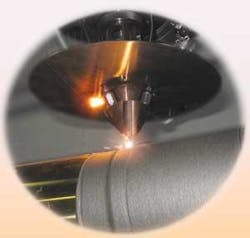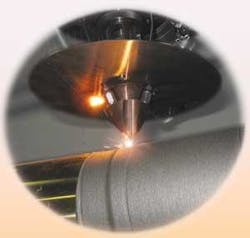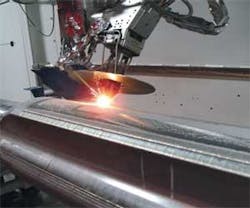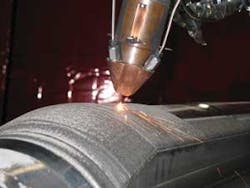A Tough Exterior
Laureen J. Belleville
Laser cladding services take generations-old company into the future
Although Dan Hayden will tell you that his wear protection and repair company purchased a laser cladding system based on “a leap of faith,” his decision on this matter is rooted in many years of experience. In fact, Dan has been fascinated by lasers since childhood. Before the purchase, both Dan and his father, John Hayden, had been on the lookout for a way to incorporate laser technology in their business, Hayden Corp. (West Springfield, MA; www.haydencorp.com), because they were certain that this would be a core technology for their industry. Today, Hayden Laser Services (HLS), a division of Hayden, leverages its extensive history in the coating and welding industry by using high-quality laser processing to address wear and corrosion problems.
Hayden Wire Works opened its doors some 89 years ago under the direction of Charles E. Hayden, an installer of wire cloth for the Springfield, MA, firm Cheney Bigelow. Hayden Wire Works wove and installed cloth for mills across the Northeast. Installation, re-covering, and repair of damaged molds (the large drums that lift the sheet of paper pulp out of the stock chests and into the network of rollers) brought a steady flow of work into the shop, and attention turned to servicing and rebuilding damaged or worn molds using methods that might extend their operational life. The company expanded to construct the entire mold using specially cast, Hayden-designed components. The company, under the founder’s son, Wes Hayden, eventually moved out of the wire cloth business altogether and focused exclusively in the field of wear protection and repair.
Under Wes, the company began offering a process for building up worn areas of paper machine components with a gun that sprayed metal. This service, called metallizing, did better than just carry its own weight. Metallizing offered a fast, easy, and cost-effective alternative to exchanging worn parts for new. Furthermore, the material used to build up a worn surface didn’t necessarily need to be the same as that it was replacing. Superior, more durable metals or ceramics could be applied that could last several times longer under the same stress. Hayden was one of the first firms to offer hardface weld overlays in tandem with thermal sprayed coatings, and it was an early applicator of high-performance spray-and-fuse style coatings. These coatings require a level of craftsmanship in their application that only comes with experience. “It requires a real skill to master the technique,” says Dan Hayden. “Furthermore, with the current employment environment, it is harder still to transfer that knowledge to the next generation.”
In the early 1980s, under John Hayden, grandson of Charles E. Hayden, the company moved to its current location. By around 1998/1999 the company began to consider using laser as a surface enhancement solution to replace the complex manual fusing process. At that time, the company was already using robotics and was investigating the use of the Nuvonyx direct diode laser to teach a robot to do what the ‘craftsmen’ were doing.
Dan’s father always believed in the laser, but was waiting for the project that would make the investment possible. Danndash;Charles’ great-grandson, a project engineer at Hayden, and managing partner of HLSndash;sees the laser as an investment in the future. In the end, the laser system purchase was prompted by a thermal spray customer (a New England machine shop) whose customer was specifying laser cladding. Hayden reasoned that because it already had QC processes and ISO certification, it had the high-tech process and training to look at laser cladding. But would such a capital investment be offset by business? Could they meet a five-year ROI? Indeed, the company expects a 17- to 24-month payback on hardware.
According to Dan, “The earlier investigation into direct diode lasers proved too risky and was abandoned before implementation. The later opportunity to enter the cladding market promised a more certain return.” This is the project that got the company involved in laser processing.
With no direct experience in laser cladding, Dan conducted extensive research on the subject, which led him to an article in Industrial Laser Solutions’ June 2002 issue written by Vivian Merchant. The article outlined the pitfalls in the process and helped him learn how to make a cladding operation work. “The key point of the article for me,” Dan remembers, “was that the equipment was only part of the equation. Knowledge and competency in several key areas was essential. This advice deeply affected the shape and composition of our new business prior to the launch.”
In 2007, Hayden Laser Services was formed specifically for the laser cladding operation. After considering all reasonable options, Hayden purchased a TRUMPF TLC 1005 system with 6kW CO2 laser and was up and running within two weeks of installation. However, the preparation took much longer. “It took six months to transform the facility, including the foundation and all the details such as plumbing and electrical,” Dan reports. “Knowing it will be a showpiece first installation of this technology for TRUMPF in the US, we did things better than we had to.”
Currently, Hayden has one major customer for the laser cladding system, comprising a few dozen different parts all for the onshore and offshore drilling and exploration industry, all of relatively high value, and all made from increasingly unavailable exotic forgings. Where HLS sets itself apart is the ability to clad extraordinarily complex features on these components using the laser cladding system’s five-axis flying optics and outboard sixth rotary axis. This ability is key in one specific part: a stabilizer shaft used in down-hole drilling applications (see photos). “With a three-year lead time to get this piece, you don’t ever want it to wear out,” Dan explains. Laser cladding is a perfect solution. Indeed, as down-hole tools become more sophisticated and exotic base materials are used, more effective wear protection becomes increasingly important for companies.
Another of Hayden’s thermal spray customers wanted something more durable, like a clad overlay for a 22 in.-dia. sphere thermal spray coated with tungsten carbide nickel chromium. Stellite 6 crack-free was needed for the bearing and seal areas of the piece. Dan explains that with the laser the melt pool and heat load are very small, which is critical to avoid damaging the thermal spray coating already in place. The project was accomplished with 3mm-wide passes overlapping at 50%.
Laser cladding provides a strong metallurgical bond with minimal dilution of the base material. This is done with minimal heat input, which also results in a small heat-affected zone. Laser cladding also has better thickness control and as-clad surface finish than traditional cladding methods. There is a small zone of base material that gets melted in with the cladding and therefore creates a good metallurgical bond compared with Hayden’s thermal spray overlays, which are only mechanically bonded to the substrate.
“Our participation in the cladding market being driven almost entirely by the transition of some components from thermal spray to laser application does much to highlight our competitive advantage,” explains Dan. “Having been in the wear and corrosion control business for more than 40 years, we had knowledge of materials and applications as well as quality control and analysis assets that are typically not available from other cladding providers,” he continues. “Basically, aside from the capital investment, cladding was a natural fit for us, and the ability to continue processing parts we would have lost otherwise was a primary motivator.”



